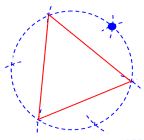Constructions: Isosceles and Equilateral Triangles
Directions for constructing isosceles and equilateral triangles:
Construct an Isosceles Triangle Using Given Segment Lengths:
When constructing an isosceles triangle, you may be given pre-determined segment lengths to use for the triangle (such as in this example), or you may be allowed to determine your own segment lengths. Either way, the construction process will be the same.
- Construct an isosceles triangle whose legs and base are of the pre-determined lengths given. Construct the new triangle on the reference line.

- Using your compass, measure the length of the given “base”.

- Do not change the size of the compass. Place your compass point on the reference line point and scribe a small arc which will cross the line.
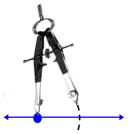
- Using your compass, measure the length of the given “leg”. Place the compass point where the previous arc crosses the reference line and scribe another arc above the reference line
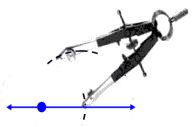
- Without changing the size of the compass, move the compass point to the point on the reference line. Scribe an arc above the line such that it intersects with the previous arc.

- You now have three points which will define the isosceles triangle.

Construct an Equilateral Triangle Using a Given Segment Length:
When constructing an equilateral triangle, you may be given a pre-determined segment length to use for the triangle (such as in this example), or you may be allowed to determine your own segment length. Either way, the construction process will be the same.
- Construct an equilateral triangle whose sides are of given length “a”. Construct the new triangle on the reference line.
- Using your compass, measure the length of the given segment, “a”.


- Do not change the size of the compass. Place your compass point on the reference line point and scribe an arc which will cross the line and will rise above the line.
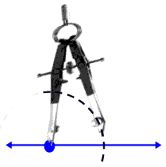
- Do not change the size of the compass. Place the compass point where the arc crosses the reference line and scribe another arc which crosses the previous arc.
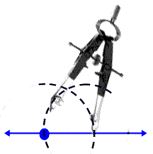
- You now have three points which will define the equilateral triangle.

Alternate Method for Constructing an Equilateral Triangle:
An equilateral triangle can be easily constructed from a circle. The secret to this method is to remember to keep the compass set at the same length as the radius of the original circle.
- Draw a circle and place a point on the circle. Do not change the size of the compass.
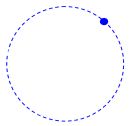
- With the compass still set at the same size as the radius of the circle, place the compass point on the point on the circle and mark off a small arc on the circle. Now, move the compass point to this new arc and mark off another arc. Continue around the circle.

- You now have a circle with six equally divided sections on its circumference.

- Connect every other point on the circle to form the equilateral triangle.
